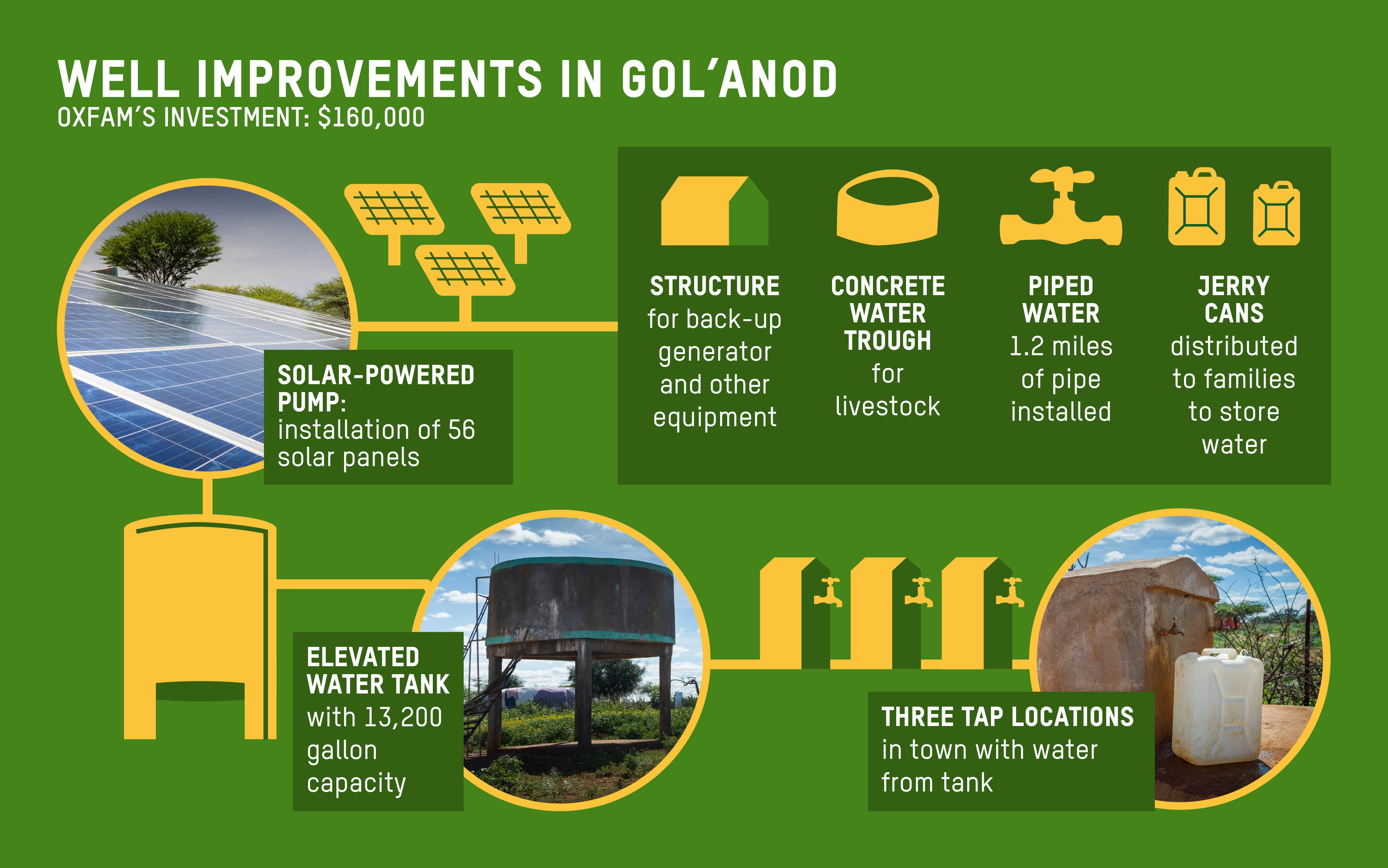New solar panels, pipes, and taps deliver water to a town surviving long-term drought.
When Amina Mohamed Abdi needs water for tea, she can now just walk across the street of her town, Gol’Anod, turn behind a small sheet-metal building, and fill a container from a set of taps. In a few moments, she is back at her shop, transferring some of the water to a small kettle, and putting it on the fire.
She says she appreciates how easy it is to get water now, compared to just six months ago. “I used to get water from another place, it took four hours,” she says. Sometimes she would return carrying water on her back, as she did not always have a donkey or a camel available to carry it for her.
“Now,” Abdi says, “it’s no distance at all.”
This improved access to water is thanks to two key developments: A well installed by the government during a particularly dry period in 2017, with a diesel-powered pump, and a subsequent upgrade by Oxfam in 2022 that installed solar panels as an alternative power source. Oxfam also piped the water into this small town in the Somali Region of southern Ethiopia, storing it in a 50-cubic-meter (more than 13,000 gallons) elevated tank that now feeds three sets of tap stands. Oxfam also set up concrete troughs for sharing the water with livestock.

The well improvements in Gol’Anod are part of Oxfam’s response to the East Africa Hunger Crisis, a multi-country humanitarian initiative to reduce the risk of famine in Ethiopia, Kenya, Somalia, and South Sudan.
Water burdens
Abdi, a 35-year-old mother of seven, says the demand for water for her family used to require a massive effort. “Even when I was pregnant, I went,” she says, adding that as her children grew up, she could no longer carry one or two with her, and had to leave them at home, adding to the stress of the hard work as she worried about leaving her kids alone for so long.
When Abdi’s eldest daughter grew up, carrying water became one of her responsibilities. Sometimes, her daughter needed to leave before dawn. “When you send your daughter to fetch water in the early morning, you are scared for her,” Abdi says. Having water nearby relieves her of such fears. “I am not afraid that she can be harmed by men on the road.”
Providing water closer to people’s homes is a priority when Oxfam assesses needs in areas affected by drought, such as Gol’Anod, which is in an area going on six years of unusually meagre rains. The objective is to cut down on the time and distance required to get water. Ayan Sharif, gender officer for Oxfam in Deghebhur in the Somali Region of Ethiopia, says this will “reduce the risk of gender-based violence for women and girls.”
Lower fuel costs
Before Oxfam installed the solar-powered pump at the well near Gol’Anod, the time, burden, and danger for women of carrying water into town was only part of the problem: Pumping the water with a diesel generator made water expensive, says Hassan Mohamed Adan, 27, the head of the water bureau in Ararso, the district in the Somali Region that includes Gol’Anod.
“The generator uses a lot of fuel,” Adan says. “It was a big challenge for the people to provide enough money to fuel the generator.”
Since Oxfam installed the solar system and pipes, Adan says, the costs to run the well is much lower.
“Oxfam has changed our society tremendously,” he says, standing next to the well and the 56-panel solar array that now powers the system in the harsh mid-day sunlight. It’s now the very source of power that brings water to the doorstep of the 350 households in Gol’Anod.
Gratitude for water
People in the Somali Region of Ethiopia are responsible for only a tiny fraction of the greenhouse gas production that is driving the climate change-induced drought in this area, but they are enduring the worst effects of the crisis.

Gol’Anod has struggled to survive successive and increasingly more frequent droughts. In 2017, many in the town left in search of humanitarian assistance, which is why the government installed the well. But even with the new well run with lower-cost solar power, people here are struggling – witnessed by a reduction in livestock herds in the area. “There used to be so many animals around here,” Amina Abdi says. “Now there are hardly any.”
Although there were some late-spring rains in 2023, it will be hard for these families to rebuild their livestock herds. But if they can, people in Gol’Anod hope the new well will help them sustain their livestock.
“Without water there is no life,” Abdi says. “We drink it, we cook with it, it is essential. Life means having water.”
She motions toward Oxfam staff visiting her shop in Gol’Anod on this day. “Our life started when this organization came to help us,” she says. “We want to thank you, we are so grateful.”
